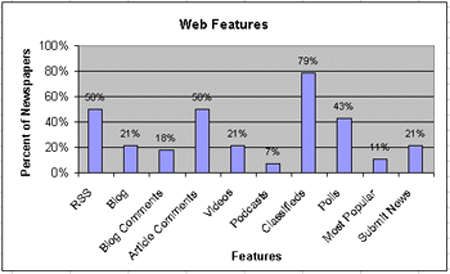After my post about the Washington Post Express' website, I decided to do some more research and see what other free newspapers are doing online. I compiled a list of free papers in the US and checked out their websites, using some of the same criteria as I did in our newspaper study. The object of this was to see if free papers are outperforming their paid-for companions on the Web.
Judging from the quality of the Washington Post Express website, I expected that free papers would have detailed websites with lots of interactive features. After all, the main target audience of most free newspapers are young professionals, who, like myself, grab a copy of a paper on their way to work rather than paying for a subscription. It makes sense that with a younger target audience, free papers would be more likely than traditional paid-for papers to expand their services online.
The popularity of free dailies are on the rise in the US. As explained in an article by the Newspaper Association of America (NAA), these publications have a lot to offer in a small (and free) package. As a result, their circulation figures are growing quickly, making free papers a seemingly viable competitor for "regular" newspapers.
"The launch of New York City’s first free daily, amNewYork, on October 10, 2003, permanently changed the newspaper landscape in the “Big Apple” and the United States. In less then 18 months, amNewYork’s weekday circulation has grown from 150,000 to 325,000. Today, it is the most-read newspaper of 18- to 35-year-olds in New York City and has the largest circulation of any paid or unpaid daily newspaper in Manhattan. Its high-energy, real-news oriented editorial approach complimented by informative feature sections and daily listing of things to do around town have secured the loyalty of what had become an illusive readership to traditional newspapers: young professionals."
Lisa Snedeker from Media Life explains the business plan of these free papers well in her March 14, 2007 article:
Typically, free sheets have favored the larger U.S. markets with extensive public transit systems, such New York, Philadelphia, Chicago and Washington, D.C., and the new free sheets will certain enter those markets. But they'll also likely reach into smaller markets.
The equation for the free sheets is rather straightforward: Give the papers away to win over readers and charge advertisers rates that are much lower than those of the big dailies. That's been the model of the Examiner chain, which now has papers in San Francisco, Washington and Baltimore and its eye on a number of other markets.
In the smaller markets the new freebies will face less competition for readers and likely a more inviting advertising climate, where the existing dailies tend to charge premium rates.
With all this hubbub about free papers, let's take a look at how the publications are doing online.
I took a look at the websites of 28 free papers in the US. By all means, this is not a comprehensive list. Unable to find good circulation data or statistics for the free papers (the ABC does not provide info on free "distribution" papers, only for paid-for publications), I was relegated to using a list I found on Wikipedia. I then double-checked with other sources to determine if the publications were actually free, as I don't trust Wikipedia. The result was a list of 28 free American papers, some daily, some weekly.
I then evaluated these websites based on the presence/lack of several features:
The results were very scattered, with no real discernible trend.
Here are some notes about particular sites that stood out in my research:
Overall, the free newspaper websites that I looked focused on providing readers with local news content, and were often geared towards younger populations. The following chart summarizes the results:

Sign up today to have our latest posts delivered straight to your inbox.